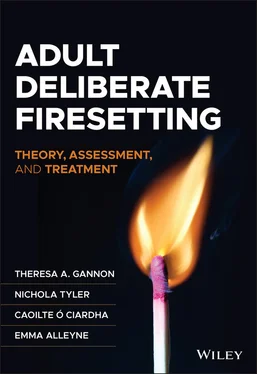Theresa A. Gannon - Adult Deliberate Firesetting
Здесь есть возможность читать онлайн «Theresa A. Gannon - Adult Deliberate Firesetting» — ознакомительный отрывок электронной книги совершенно бесплатно, а после прочтения отрывка купить полную версию. В некоторых случаях можно слушать аудио, скачать через торрент в формате fb2 и присутствует краткое содержание. Жанр: unrecognised, на английском языке. Описание произведения, (предисловие) а так же отзывы посетителей доступны на портале библиотеки ЛибКат.
- Название:Adult Deliberate Firesetting
- Автор:
- Жанр:
- Год:неизвестен
- ISBN:нет данных
- Рейтинг книги:5 / 5. Голосов: 1
-
Избранное:Добавить в избранное
- Отзывы:
-
Ваша оценка:
- 100
- 1
- 2
- 3
- 4
- 5
Adult Deliberate Firesetting: краткое содержание, описание и аннотация
Предлагаем к чтению аннотацию, описание, краткое содержание или предисловие (зависит от того, что написал сам автор книги «Adult Deliberate Firesetting»). Если вы не нашли необходимую информацию о книге — напишите в комментариях, мы постараемся отыскать её.
Explore the theoretical foundations of—and discover effective treatment options for—adults who deliberately set fires Adult Deliberate Firesetting: Theory, Assessment, and Treatment,
Adult Deliberate Firesetting: Theory, Assessment, and Treatment
Adult Deliberate Firesetting — читать онлайн ознакомительный отрывок
Ниже представлен текст книги, разбитый по страницам. Система сохранения места последней прочитанной страницы, позволяет с удобством читать онлайн бесплатно книгу «Adult Deliberate Firesetting», без необходимости каждый раз заново искать на чём Вы остановились. Поставьте закладку, и сможете в любой момент перейти на страницу, на которой закончили чтение.
Интервал:
Закладка:
Prevalence of Deliberate Firesetting
How we define firesetting has an impact on the consistency, and sometimes validity, of how we measure its prevalence. As a result, the manner in which fire data and statistics are recorded and reported makes it difficult to establish the true prevalence of deliberate firesetting across countries (Meacham, 2020). Looking solely at conviction rates for arson offences would massively underestimate the scale of the problem given the low detection and clearance rates for deliberate firesetting (see Chapter 5). Additionally, in many countries, published crime statistics routinely combine criminal damage and arson offences, making it difficult to parse firesetting prevalence from other forms of property offences. From a researcher’s perspective, not all data are publicly accessible or searchable by people who cannot speak the language of the reporting country if translations are not available.
Where data are available, estimates can vary wildly depending on the recording agency and the definitions used. When we examine data from the US, for example, the FBI suggest that there are approximately 13 or 14 wilfully set fires annually for every 100,000 inhabitants (Federal Bureau of Investigation, 2015, 2018b) where an investigation has determined the fire to be deliberate. However, numbers from the US National Fire Protection Association, using a broader definition of “intentional” firesetting, suggest that the annual rate of intentional firesetting may be as high as 83 incidents per 100,000 inhabitants 1 (Campbell, 2017). It is worth noting that this higher figure may also include a proportion of firesetting incidents where the cause remained undetermined or may otherwise not have met the FBI definition.
In the UK, deliberate firesetting is operationalised within government figures as fires that have been attended by the Fire and Rescue Service and the motive recorded as deliberate. The most recent statistics available for England suggest that there were approximately 122 deliberate fires per 100,000 inhabitants annually in 2019 and 2020 (Home Office, 2021). Canadian statistics for the years spanning 2015 to 2019 suggest that rates of arson incidents are consistently between 22 and 27 per 100,000 (Statistics Canada, 2021). Data from Ireland’s Central Statistics Office (2016) on the number of arson incidents recorded by police in 2015 suggest that there were 37 reported arson incidents per 100,000 inhabitants. Data reported by Ketola and Kokki (2018) suggest that Finnish rescue services recorded approximately 20 deliberate fires per 100,000 residents.
Smith et al. (2014) used data from four Australian states to estimate the number of recorded victims of arson in Australia in 2011. Based on the figures calculated by Smith et al. (2014), we estimate that there were approximately 67 victims of arson for every 100,000 inhabitants in Australia at this time. These figures are broadly consistent with the annual rate per hundred thousand of arson offences recorded in one Australian state (Victoria) spanning 2011–2016, which ranged from 57 to 74 per 100,000 inhabitants (Crime Statistics Agency Victoria, n.d.). However, Smith et al. (2014) also estimated, based on Mayhew (2003), that there are two unreported arson victims for every case reported to the police, suggesting that the annual prevalence of arson victimisation in Australia may be as high as 200 per 100,000. Thus, it would be sensible to assume a similar under-reporting of arson in the other jurisdictions where rates are available.
We caution against comparing these figures cross-nationally because the methods of data collection vary considerably across jurisdictions. However, we consider it reasonable to estimate that the annual prevalence of deliberate firesetting serious enough to be reported to police or demand attention from fire services in the countries discussed may be in the range of 40–200 incidents per 100,000 inhabitants, when taking under-reporting into account (Mayhew, 2003; Smith et al., 2014). It remains an open question whether variability in these figures across countries reflects true cross-national differences in the rate of firesetting or is an artefact of differences in reporting and/or investigation practices between countries.
An alternative to examining rates of deliberate firesetting recorded in agency records is to use self-reported firesetting as an indicator of prevalence. To date, the most robust self-report study to ask about self-reported deliberate firesetting was the US National Epidemiologic Survey on Alcohol and Related Conditions (Blanco et al., 2010; Vaughn et al., 2010). This dataset, representative of the US population, included whether participants answered yes to the question “In your entire life, did you ever start a fire on purpose to destroy someone else’s property or just to see it burn?” Using this broad—but property-focused—definition, approximately 1% of participants reported to have a lifetime prevalence of deliberate firesetting (Blanco et al., 2010; Vaughn et al., 2010).
As clinicians, one of the first questions asked is how prevalent is this offending behaviour? This helps to understand whether the behaviour requires resources invested to address it. The definitional and measurement issues presented thus far demonstrate that the research evidence needs to be interpreted with care and needs to be framed within the context of the criteria for which data are collected and recorded.
Adult Firesetting as a Neglected Topic of Research
Research examining the psychological factors underpinning firesetting behaviour and treatment for firesetting has undergone a sea change in the past decade or so. Prior to this, research on adult firesetting appeared occasionally in the literature and had relatively minimal impact. However, since the publication of a review of the state of the literature by Gannon and Pina in 2010, there have been year-on-year increases in the number of outputs on firesetting, which have impacted on the wider psychological and criminological literature. Even older papers (e.g., Inciardi, 1970; Jackson et al., 1987) have seen notable increases in rates of citation in the past decade as a new generation of researchers revisits these canonical sources. It appears that sustained research from a number of research teams (especially in the UK and Australia) from 2010 onwards resulted in a critical mass for the topic. This critical mass was likely brought about by researchers and research funders recognising that adult firesetting reflects a major public health and criminal justice concern with a large human and financial cost.
The neglect of adult firesetting as a research topic likely stems from an interaction of factors. First, research on firesetting has historically focused on firesetting behaviour in children and adolescents. We will explore the reasons for this and the contribution of this literature to the understanding of adult firesetting. Second, it appears that there was a general belief that firesetting could be explained by either mental disorder (i.e., pyromania) or by general criminality (e.g., people setting fires to claim insurance or destroy evidence). Given that diagnoses of pyromania are exceptionally rare, there may have been a belief that firesetting behaviour was mostly addressable through general criminal offending programs. Readers of this book will see that the evidence base now suggests that many individuals who set fires have unique characteristics (see Chapter 2) requiring tailored risk assessments (see Chapter 4), and crucially, would benefit from interventions designed to target their distinct treatment needs (see Chapters 6and 7).
Key Developments in the Childhood Firesetting Literature
The firesetting literature has had an asymmetrical focus on children who set fires despite evidence that only half of fires are set by children (Cassel & Bernstein, 2007). There are likely to be a number of reasons for this asymmetry, including (1) a lack of awareness of the prevalence or seriousness of adult firesetting, (2) an assumption that firesetting was a fire safety and thus educational challenge, and (3) a belief that childhood firesetting may be indicative of serious and violent offending in adulthood (e.g., the “MacDonald triad”). Based on interviews with 100 residents in a psychiatric facility, MacDonald (1963) concluded that the presence of (1) enuresis (beyond 5 years of age), (2) animal cruelty, and (3) firesetting during their childhoods, taken together, was a prognostic indicator of future violence (operationalised as “threats to kill”). The clinically appealing nature of this study for diagnostic and risk assessment purposes appears to have resulted in its wide-spread and continued application (Barrow et al., 2014). This is despite MacDonald’s findings never being replicated. Instead, the evidence suggests that the presence of either animal cruelty or firesetting during childhood is more indicative of dysfunctional and abusive childhoods (i.e., environments that normalise violent behaviour) rather than violent behaviour itself (Parfitt & Alleyne, 2020).
Читать дальшеИнтервал:
Закладка:
Похожие книги на «Adult Deliberate Firesetting»
Представляем Вашему вниманию похожие книги на «Adult Deliberate Firesetting» списком для выбора. Мы отобрали схожую по названию и смыслу литературу в надежде предоставить читателям больше вариантов отыскать новые, интересные, ещё непрочитанные произведения.
Обсуждение, отзывы о книге «Adult Deliberate Firesetting» и просто собственные мнения читателей. Оставьте ваши комментарии, напишите, что Вы думаете о произведении, его смысле или главных героях. Укажите что конкретно понравилось, а что нет, и почему Вы так считаете.












